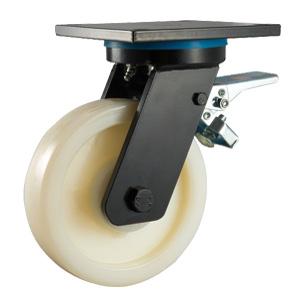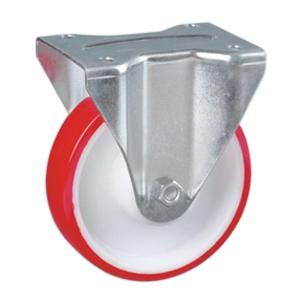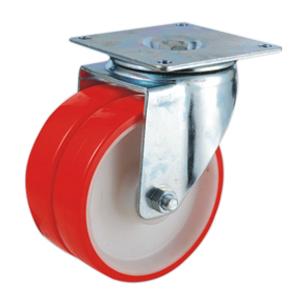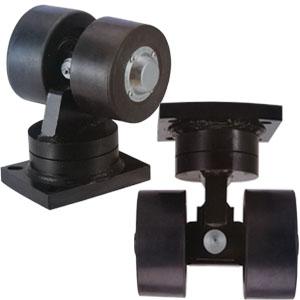Different between single wheel casters and twin casters
16 Nov / 2023Casters play a crucial role in enabling the mobility of equipment, furniture, and various objects in a wide range of settings. Single wheel casters and twin casters represent two common categories of casters, each offering unique features and benefits. Understanding the differences between these two types is essential for selecting the most suitable option for specific applications.
**Single Wheel Casters: Design and Characteristics**
Single wheel casters consist of a single wheel attached to a mounting frame. These casters are commonly used in light to medium-duty applications and are ideal for maneuvering furniture, carts, and institutional equipment. The following are the key design and characteristics of single wheel casters:
1. **Load Capacity**: Single wheel casters are designed to support lighter loads compared to twin casters. Their load capacity typically ranges from 30 to 150 pounds per caster, making them suitable for applications where the weight of the object being moved is within this range.
2. **Floor Surface Compatibility**: The choice of wheel material for single wheel casters depends on the type of floor surface they will be rolling on. Factors such as hardness, texture, and potential damage to the floor must be considered when selecting the appropriate wheel material.
3. **Swivel Design**: Single wheel casters are available in both swivel and rigid designs. Swivel casters allow for multidirectional movement, offering enhanced maneuverability in confined spaces, while rigid casters move only along a straight path.
4. **Braking Mechanism**: Depending on the application, some single wheel casters may be equipped with braking mechanisms to ensure stability when stationary, preventing unintended movement.
5. **Noise and Vibration**: The design and materials used in single wheel casters affect noise and vibration levels during operation. Minimizing these factors is essential, especially in environments where excessive noise or vibration can be disruptive.
**Advantages of Single Wheel Casters**
- Maneuverability: Single wheel casters excel in maneuvering through tight spaces due to their swivel design, making them ideal for applications that require flexibility in movement.
- Compact Design: The single wheel configuration allows for a more compact overall footprint, making single wheel casters suitable for space-constrained environments.
- Cost-Effective: Single wheel casters are often more cost-effective than twin casters, providing reliable performance for light to medium-duty applications while offering economical solutions.


**Twin Casters: Design and Characteristics**
Twin casters, also known as dual wheel casters, feature two wheels mounted side by side on a single frame. They are designed to support heavier loads and provide stability in demanding applications such as industrial equipment, heavy-duty carts, and aerospace ground support equipment. The following are the key design and characteristics of twin casters:
1. **Load Distribution**: Twin casters are engineered to distribute the load over a larger surface area, reducing the pressure exerted on the floor and providing enhanced stability for heavy loads. This load distribution capability allows twin casters to support significantly higher weights compared to single wheel casters.
2. **Wheel Material and Size**: The choice of wheel material and size is critical for twin casters, as it directly impacts load-bearing capacity, floor protection, and overall performance. Materials such as polyurethane, rubber, and nylon are commonly used to ensure durability and floor protection.
3. **Swivel Locking Mechanism**: Some twin casters are equipped with swivel locking mechanisms, allowing users to switch between swiveling and fixed-wheel functionality. This feature enhances versatility in different operating environments, providing both maneuverability and stability when needed.
4. **Maintenance**: Twin casters may require more maintenance than single wheel casters due to the complexity of their design. Regular inspection, cleaning, and lubrication are essential to ensure optimal performance and longevity.
**Advantages of Twin Casters**
- Enhanced Load Capacity: Twin casters are capable of supporting significantly heavier loads compared to single wheel casters, making them suitable for heavy-duty applications in industrial, aerospace, and other demanding environments.
- Floor Protection: The distributed load of twin casters reduces the pressure exerted on the floor, minimizing the risk of damage, especially on softer or more delicate surfaces. This feature is particularly important in industrial settings to protect flooring and prevent accidents.
- Stability: The wider footprint of twin casters provides greater stability, especially when navigating uneven terrain or transporting heavy loads over longer distances. This stability is critical for maintaining safety and control in challenging operational conditions.


**Application Considerations**
The choice between single wheel casters and twin casters depends on the specific requirements of the application. Understanding the distinct characteristics and advantages of each type is essential for making informed decisions. Here are some common applications for each type:
**Single Wheel Casters Applications:**
- Furniture: Chairs, tables, cabinets, and other household or office furniture often utilize single wheel casters for easy mobility.
- Medical Equipment: Utility carts, stands, and medical trolleys benefit from the maneuverability offered by single wheel casters in healthcare facilities.
- Retail Fixtures: Displays, shelves, and retail fixtures use single wheel casters to facilitate reconfiguration and movement within retail environments.
- Light-Duty Industrial Carts: Dollies, carts, and mobile platforms in light industrial settings often employ single wheel casters for their compact design and maneuverability.
- Institutional Equipment: Trolleys, utility carts, and service equipment in institutional settings utilize single wheel casters for ease of use and mobility.
**Twin Casters Applications:**
- Aerospace Ground Support Equipment: Aircraft maintenance platforms, ground support equipment, and aerospace tooling carts rely on the load-bearing capacity and stability provided by twin casters in aerospace facilities.
- Heavy-Duty Industrial Carts: Material handling carts, industrial workstations, and heavy-duty platforms use twin casters to support and transport substantial loads in manufacturing and warehouse environments.
- Automotive Industry: Tool chests, mobile workstations, and automotive service equipment benefit from the stability and load-bearing capacity of twin casters in automotive repair and maintenance facilities.
- Large-Scale Manufacturing: Machinery, equipment, and assembly line components in large-scale manufacturing operations utilize twin casters for their ability to support heavy loads and provide stability during movement.
- Rugged Outdoor Environments: Carts, platforms, and equipment used in outdoor settings such as construction sites and agricultural operations rely on twin casters for their durability and performance on challenging terrain.
**Conclusion**
In conclusion, the selection of single wheel casters or twin casters involves considering several factors, including load capacity, floor surface, maneuverability, and specific application requirements. Each type offers distinct advantages and is well-suited for particular applications. By understanding the unique characteristics of single wheel casters and twin casters, individuals and organizations can make informed decisions to ensure optimal performance, safety, and efficiency in their respective applications. Whether it's maneuvering furniture with single wheel casters or transporting heavy loads with twin casters, choosing the right type of caster is essential for facilitating smooth and reliable mobility across various industries and environments.